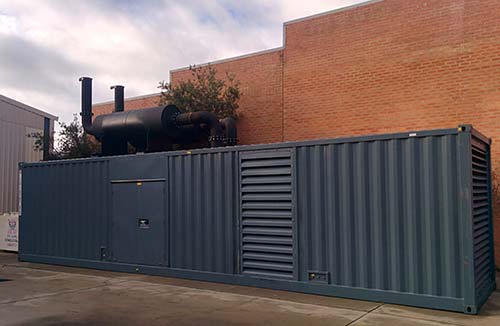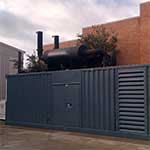What is EPC Generator Design?
This is the process of engineering, procurement and construction of electrical generator sets ("gensets") for specific needs. Gensets are often used as backup or emergency power, but are regularly used for project-related work when the primary source cannot accommodate project needs or is not yet available. Typical EPC gensets range in power output from 200kVA to 2MVA, powering a single piece of equipment or area up to an array of gensets powering an entire site. Starting an entire operations site or a significant part of one can be a complex process that requires sophisticated power generation functions. For example, the starting current required for drives is significantly greater than generally running current requirements. Therefore, understanding the electrical power needs of an operation can inform generator selection and design.
Features in EPC Generator Design
Generators can be designed for simplicity, but can also have a number of features built in to provide extra functionality. Depending on the complexity of an electrical network or a project's needs, generator design can include the functions described below.
Project Integration
Whilst many vendors supply off-the-shelf generators, these may not include features a particular project needs or include features which have no use. Therefore, with off-the-shelf options, there is the potential that fit-for-purpose is not achieved or that a project wastes part of its budget on unneeded generator functionality.
Bumpless Transfer for Electrical Generators
The downtime and unexpected costs associated with disconnecting and reconnecting an electrical network to a genset can be avoided with prior preparation. Gensets will be programmed to synchronize to a client's primary network's supply before switching over to primary supply and back, saving time and operational risk.
Bulk Tanks
Gensets come with their own "day tanks" (or "belly tanks") that typically provide 4-12 hours' worth of fuel at full load. These can be connected to a "bulk tank", which allows for much longer periods of backup supply.
Bulk tanks serve as above-ground fuel sources with a pump and associated control for gensets. Historically, they were used by backup and emergency gensets to provide 24 hours' worth of fuel. Nowadays, these can be of any size depending on client requirements, usually relating to the power usage of associated equipment and the expected likelihood of blackout periods. Bulk tanks can be directly interfaced to the genset and automatically transfer their fuel when needed.
Automatic Black Start Capability
This system can be designed to come online automatically after a loss of mains power has been detected for a period of time. The genset can be brought online and supply an area of plant, allowing for operator-free or limited input to restore important systems with minimal downtime. This is done in combination with disconnecting the primary source of supply so that the system works as an islanded network. When the original mains supply has been restored to stability, the islanded network is then reconnected.
Cogeneration
Electrical cogeneration involves planned real-time load balancing between utility/mains power (e.g. power plant) and a backup generator. This allows for the genset to be run in maintenance mode regularly to verify system integrity and that it will run as needed during a mains power failure. Additionally, maintenance operation prevents diesel stagnation, removing the need to dump diesel tanks after a period of inactivity.
Steps in EPC Generator Design
A rough process to EPC generator design involves:
- Understanding client requirements and project needs
- Design
- Programming
- Construction
- Testing
- HV submission (if required)
- Delivery
- Commissioning
What makes a quality genset design?
Depending on the resources and expertise applied to the above process, final asset owners may or may not end up with a genset which meets their needs. In our experience, thorough testing before a generator arrives on site makes a large difference. Such testing should involve the use of load banks and the verification of sequences. Additionally, a detailed analysis of requirements at the start of the project is important for the successful delivery of an EPC genset project. This allows us to ensure that the delivered project is fit-for-purpose.
Teck Global designs EPC generators in Perth
At Teck Global, we supply gensets ranging between 200kVA and 2MVA, from conceptual design to final on-site verification. Our customised designs can integrate a host of different functions, such as bumpless transfer, automatic black start ability, cogeneration and more. We approach our projects in ways that reduce risks and save costs and encourage any clients with genset needs (including genset hire) to contact us to see how we can help.


